Rosh Hashanah in the Golden Age of Postcards
Views: 521
Jewish New Year Highlighted in Postcards
A Lost Art Rediscovered
By Michael Perlman
The first American “picture postcard” was produced in 1873. Today, a significant number of postcards from the late 19th and early to mid-20th century surprisingly exist in a good to excellent state, with fine penmanship and one-cent domestic stamps and two-cent international stamps.
Rosh Hashanah, which is known as the “Beginning of the Year” and also referenced as the Day of Judgment and Day of Remembrance, will be observed from the evening of October 2 until the evening of October 4 on the Gregorian calendar, but is Tishrei on the Jewish calendar. The year 5785 will be brought in by attending services and reviewing one’s relationship with G-D and repenting. It is a tradition to blow the Shofar and eat challah or apples dipped in honey for a sweet year. Over a century ago, it was also customary to mail a hand-colored Rosh Hashanah postcard.
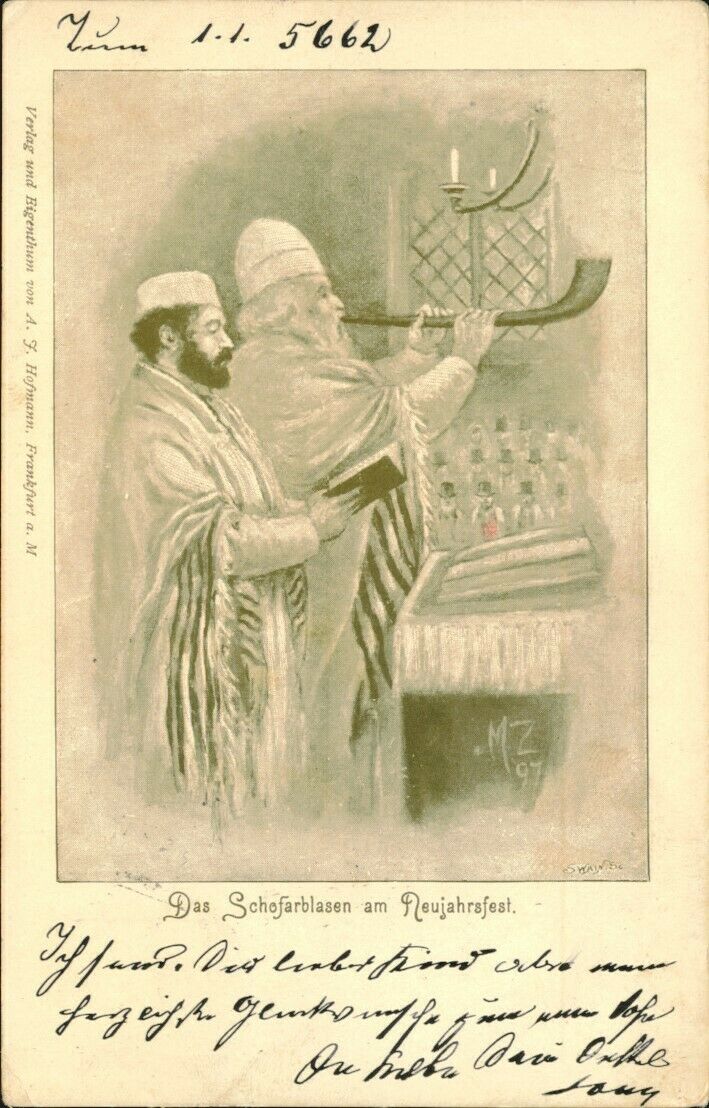
A scarce 1901 postcard, Shofar blowing
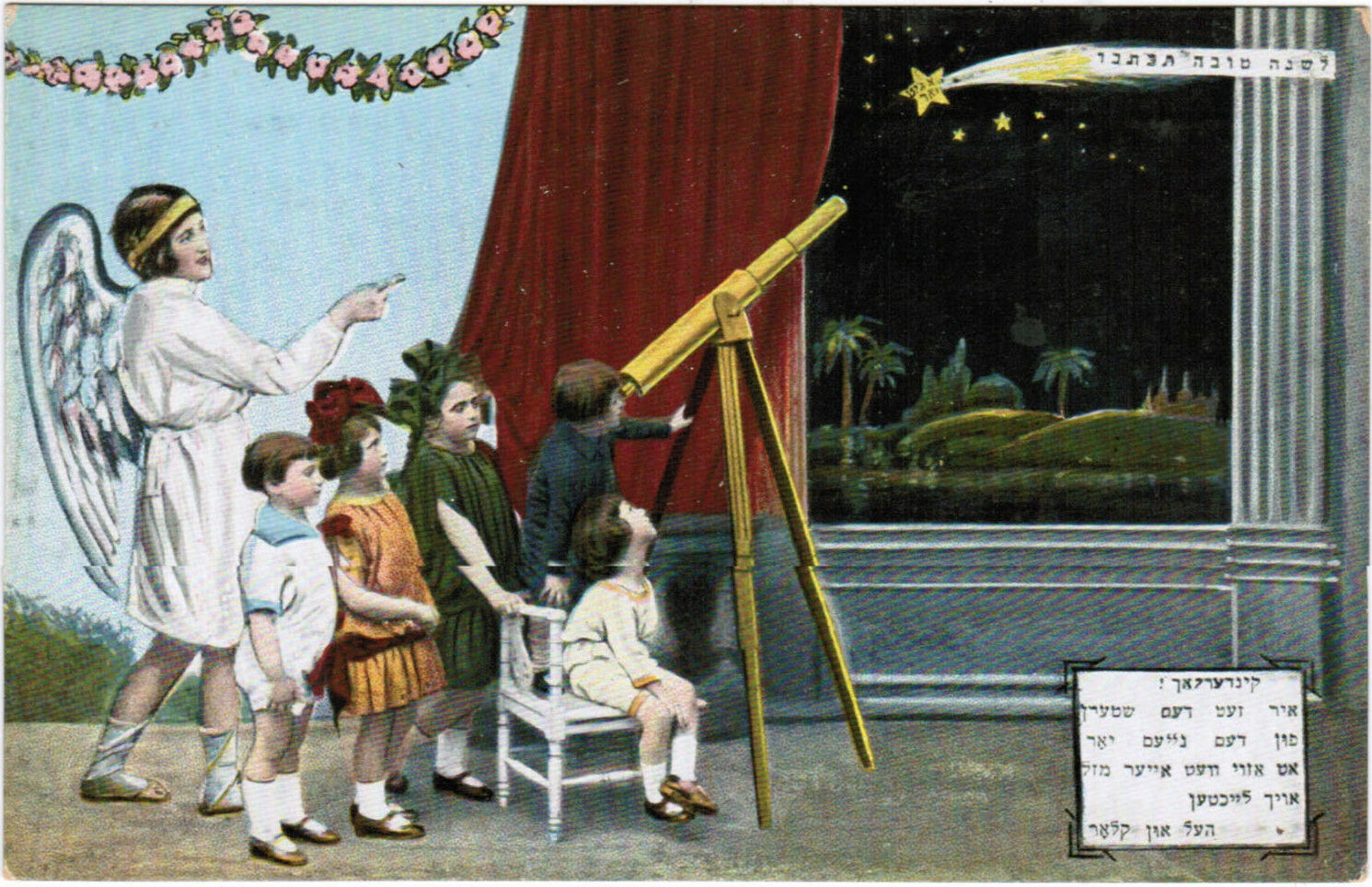
Angel joins children who are star-gazing
Deltiology is the collection and study of postcards, which derives from “deltion,” a Greek term for a writing tablet or letter. A postcard collector is a deltiologist. Several decades ago, postcards could be found at a corner pharmacy, but today, vintage postcards are found on eBay, at estate sales and postcard shows, or perhaps in a dusty box in your attic, left behind by an earlier homeowner. Nearly every theme is represented, including holidays, hometowns, and hobbies.
The majority of postcards were published between 1898 and 1918, with those from the 1920s and 1930s in fewer quantities. Today, all are considered to be collectible works of art and range from a few dollars to over one hundred dollars, depending on their artistry, publisher, and rarity. It is estimated that by 1913, nearly one billion postcards were mailed in America.

A Tashlich ritual near the Brooklyn Bridge, A rare postcard
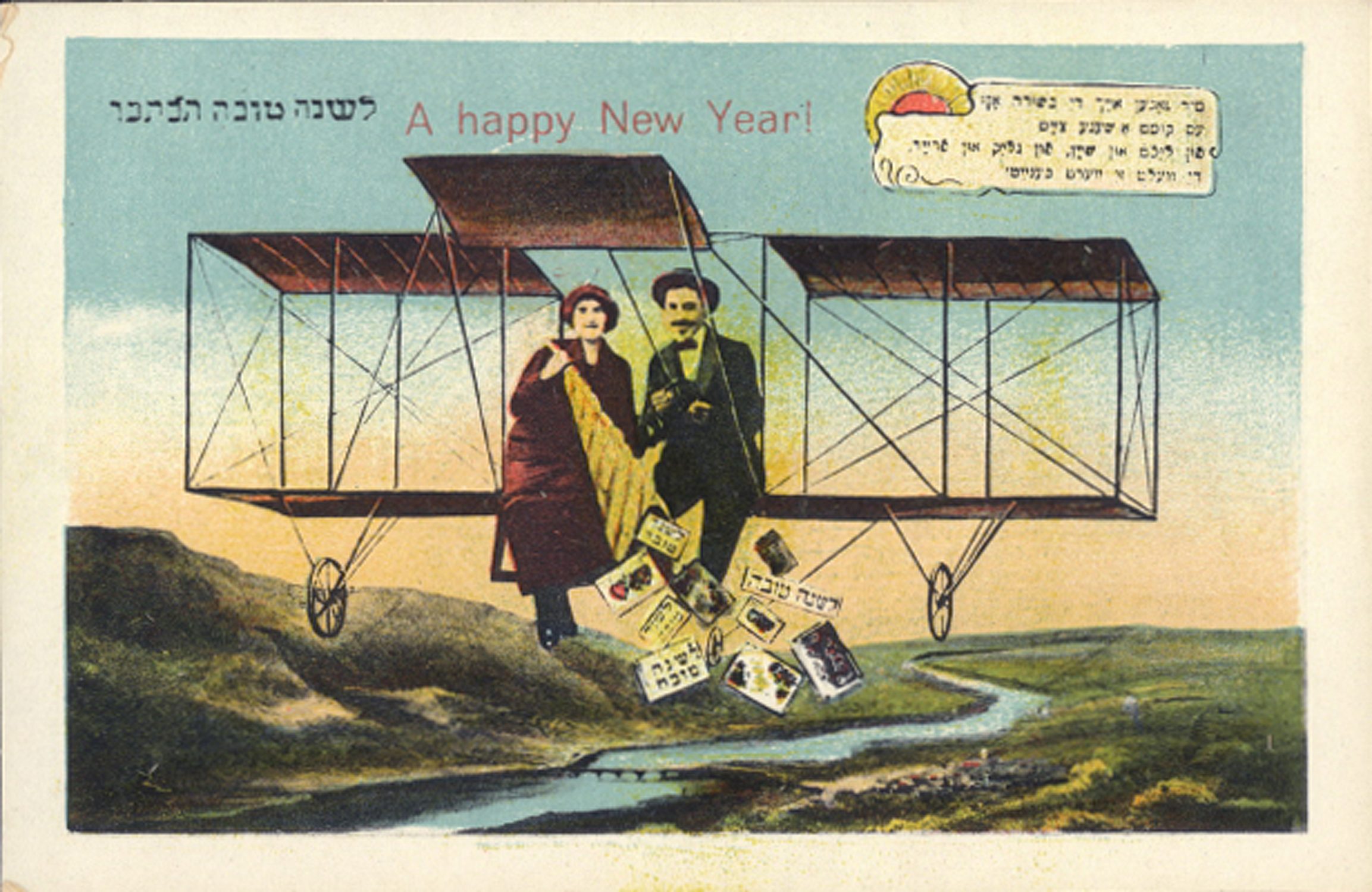
Couple on plane for Tashlich, Williamsburg Post Card Company
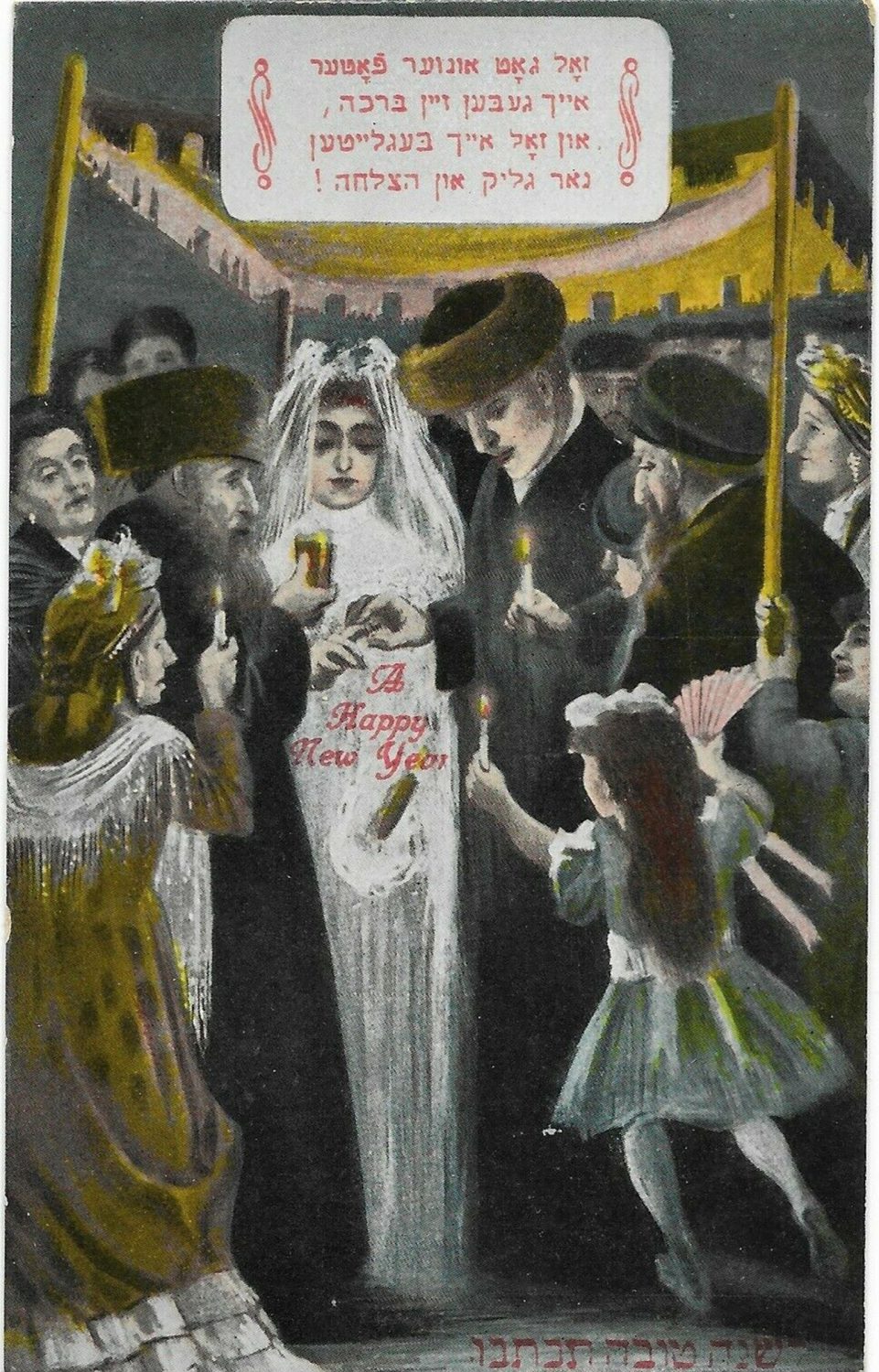
Under the Chuppah, Marriage ceremony, Williamsburg Art Co postcard
Most Rosh Hashanah postcards are graceful lithographs, where some feature hand-colored traditional home scenes with families having a festive meal in honor of the holiday, as well as couples interacting harmoniously or romantically. Street scenes may include a synagogue or a lake for Tashlich, a ritual which signifies casting away one’s sins. Floral elements and animal scenes can also be observed. Traditional Jewish elements were incorporated into various scenes, including yontef candle-lighting (holiday that forbids work), davening (praying), Shofar-blowing (symbolic ram’s horn instrument), and tallites (shawls).
As a result of a very successful market, some Rosh Hashanah postcards would feature various renditions of the same actors and actresses in studios. At times, families were depicted in a variation of both worlds on the same postcard or different postcards, wearing traditional European clothing, reminiscent of their home country, as well as clothing that was deemed fashionable by American standards. Old World and New World themes were prevalent. Postcards helped families remain connected between native countries and America, as well as from state to state.
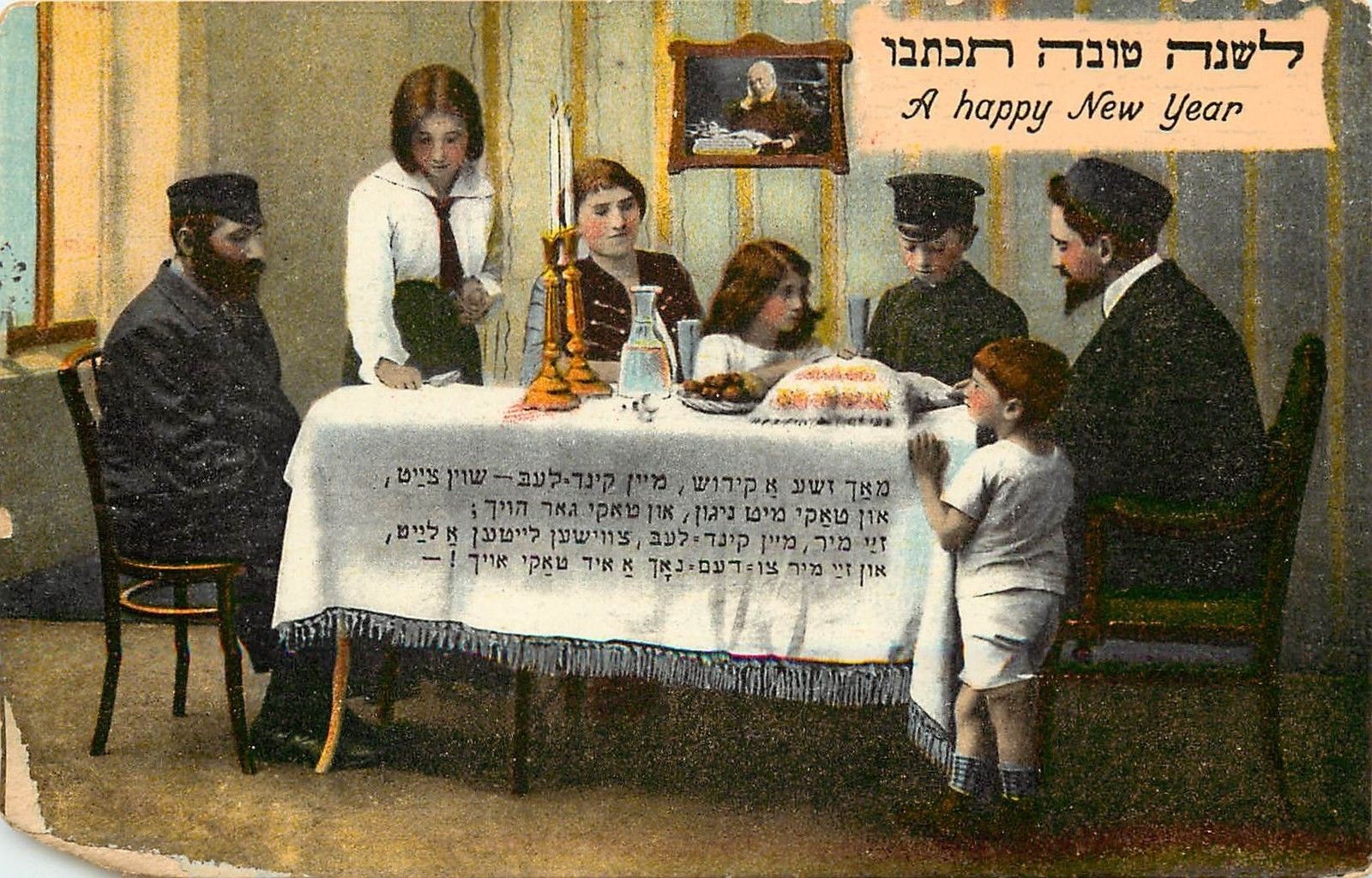
A family gathering around a traditional dinner table for Rosh Hashanah, Williamsburg Art Company
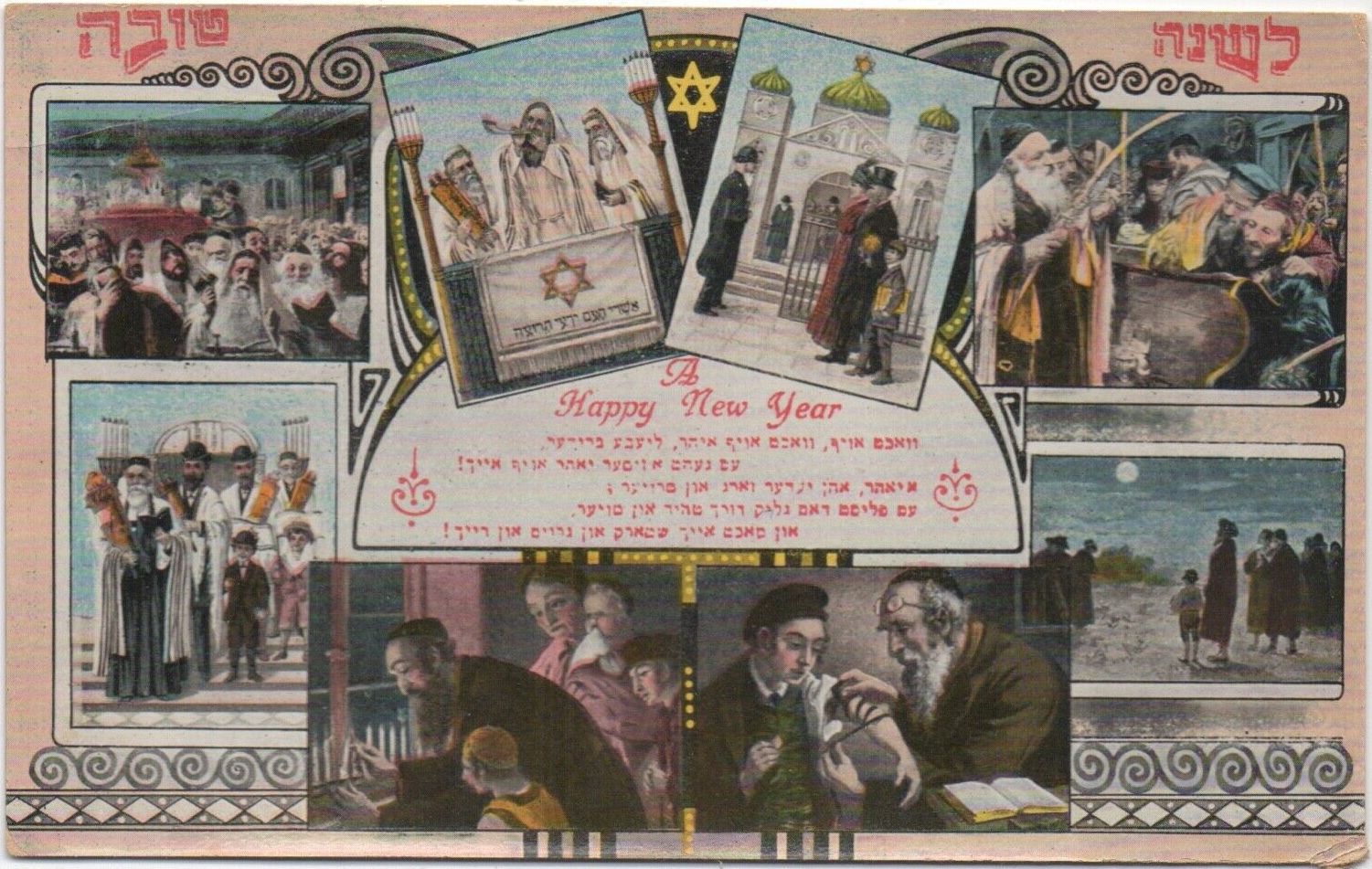
Anticipating Jewish holidays after exchanging Rosh Hashanah greetings, An early Williamsburg Art Co postcard
On occasion, innovative objects such as telescopes, the radio, telegraph, bicycles, airplanes, hot air balloons, cars, boats, and trains were captured, to emphasize happiness and hopes for productivity and new opportunities in the year to come, while embracing the American Dream. In the early 20th century, there was also a common belief and optimistic perspective, where technology could foster peaceful relations globally. Children, couples, or families would say “Shana Tovah,” Hebrew for “Happy New Year” from a plane or bicycle, for example. Postcards would also state, “L’Shana Tovah Tikatevu,” which means “May you be inscribed in the Book of Life for a good year.”
Decorative motifs enhanced postcards, often in the Victorian or Art Nouveau style. Some postcards were even embossed, adding to their interactive nature.
A major postcard publishing firm for Rosh Hashanah postcards, among other forms of art, was the Williamsburg Art Company or Williamsburg Post Card Company, situated at 25 Delancey Street and later 20 West 20th Street. This firm printed their postcards in Germany, despite being based in Manhattan. Part of their mission was to focus on the Eastern European and Yiddish market in America.
Designers operated in America and Europe, as printers brought the Rosh Hashanah postcards into fruition in Germany and Poland to benefit the influx of patrons in America and Latin America who understood Yiddish.

Rosh Hashanah, Synagogue postcard
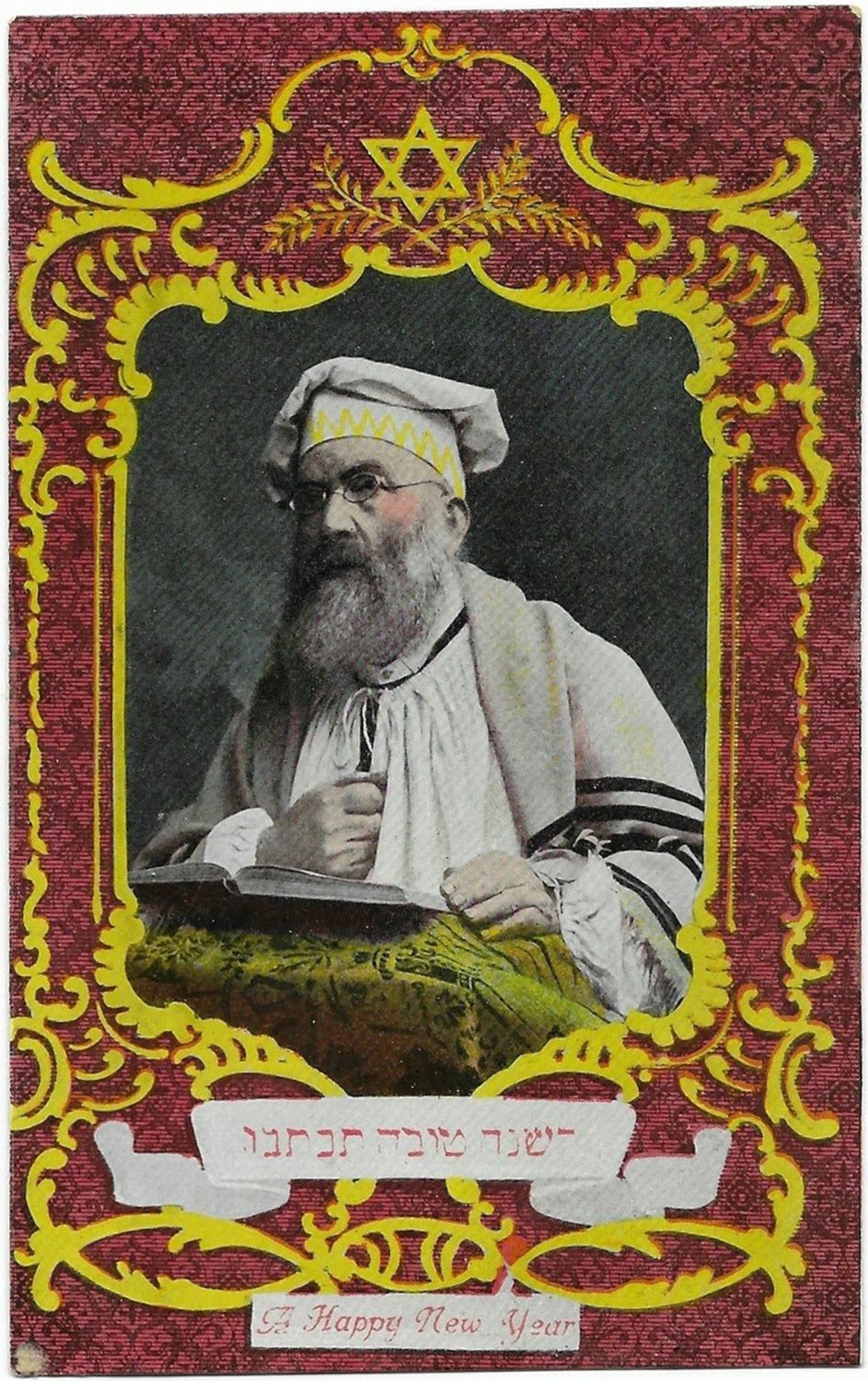
A rabbi with an ornate motif, Williamsburg Art Co
Haim (Haggai) Goldberg, who was born circa 1888 in Lukow, Poland and perished in the Bialystok Ghetto in 1943, is remembered as a prominent Jewish Polish illustrator, graphic designer, photographer, and printer, in addition to a Hebrew and Yiddish poet and writer. He is also remembered as an amateur painter. He studied in a yeshiva and later opened a photography studio in Warsaw in 1912. Then was appointed by the Yehudiya publishing house under the Yiddish daily Haynt as a graphic designer of greeting cards and postcards. Goldberg was popular for creating his own style. Operating from his studio, he created scenes featuring amateur actors wearing traditional attire. Then he further applied his talents through painting and graphics to incorporate illustrated elements, and also featured his original Yiddish rhymed greetings.
Shalom Sabar, a Jewish art and folklore professor, regards Goldberg as a most significant Rosh Hashanah card designer, who pursued his talents in the early 20th century.
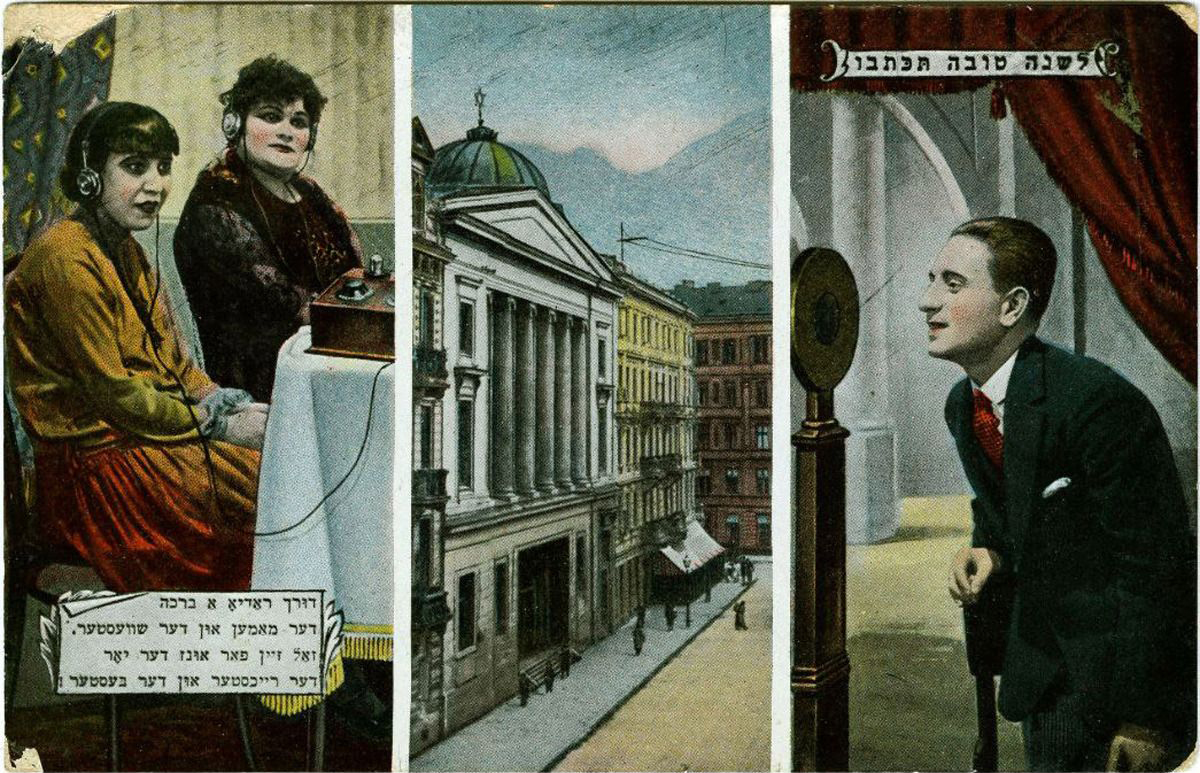
Embracing technology & optimism in the early 20th century
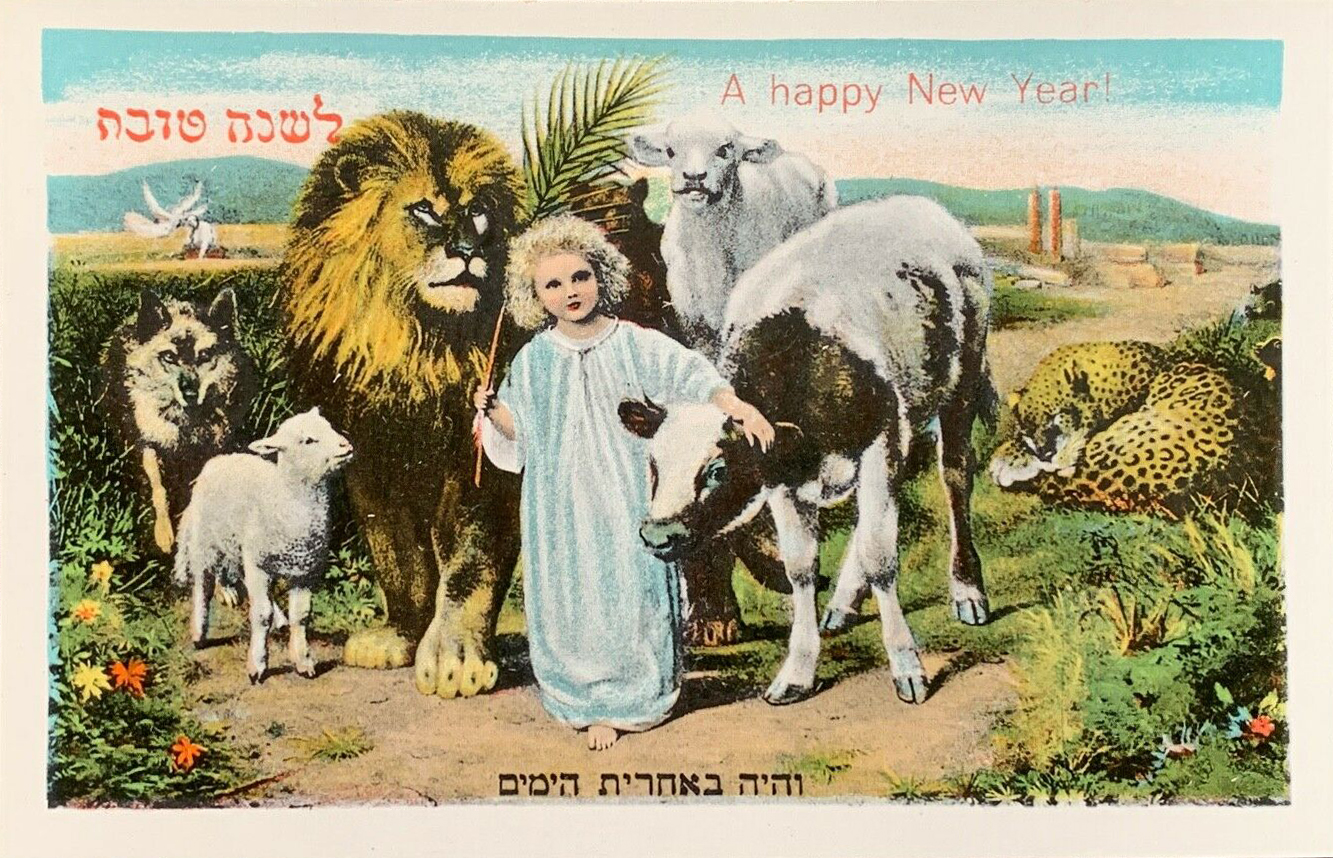
Embracing diverse animals to symbolize life
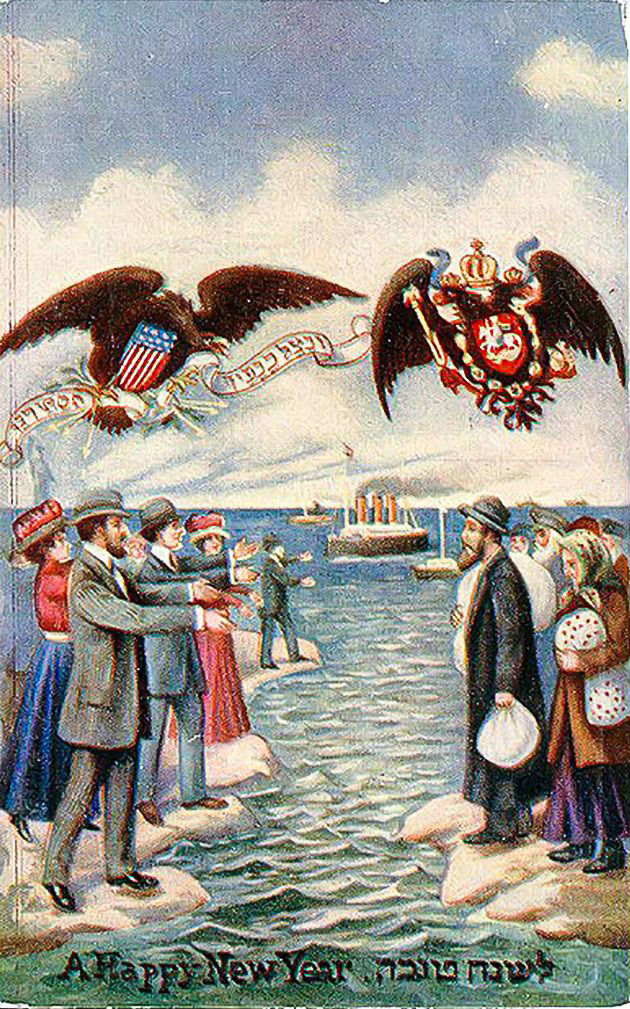
Welcoming immigrants
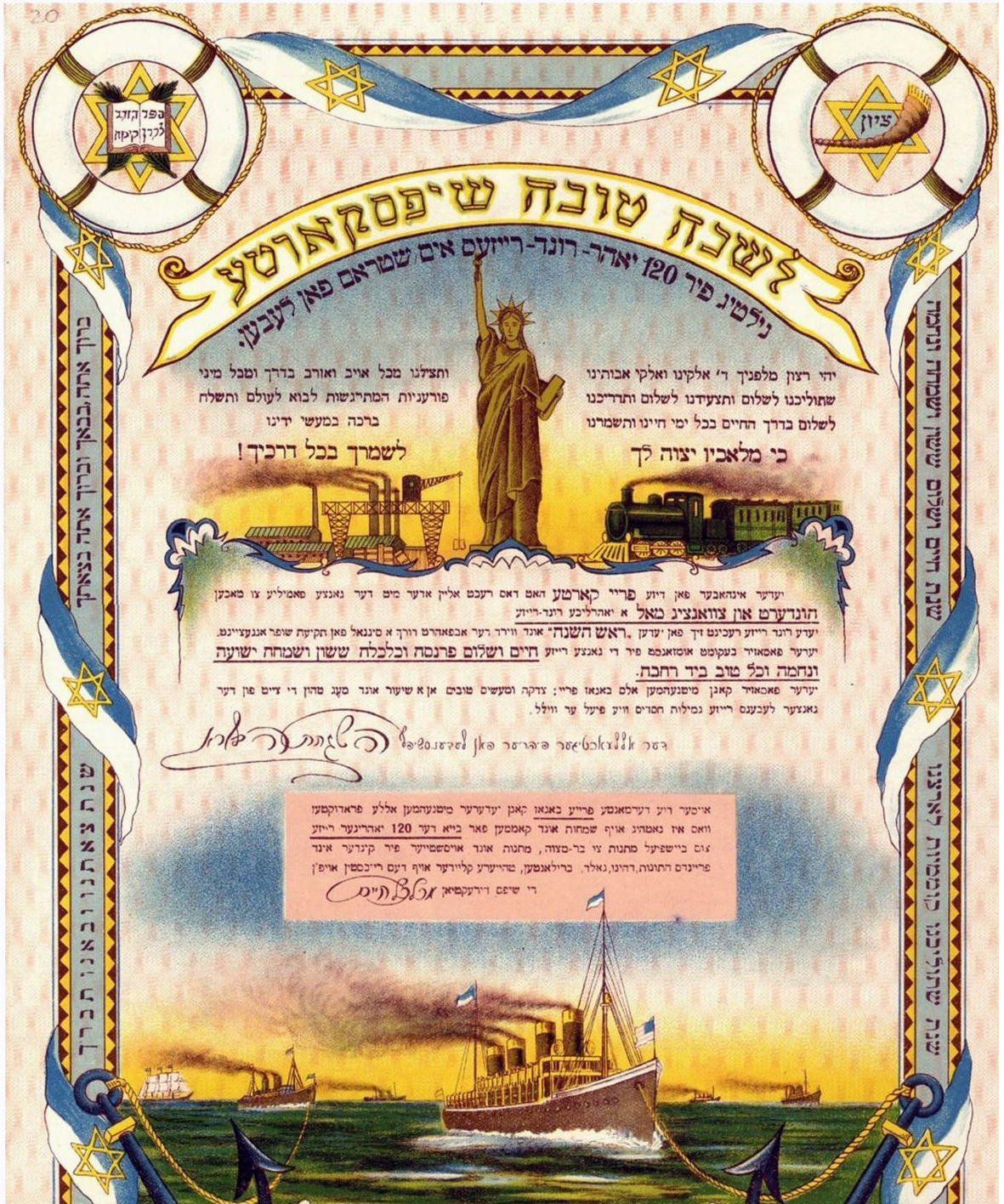
Technology, unity, & blessings in the land of opportunity

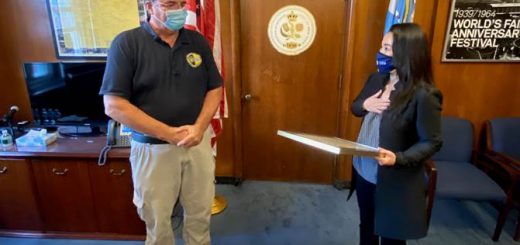
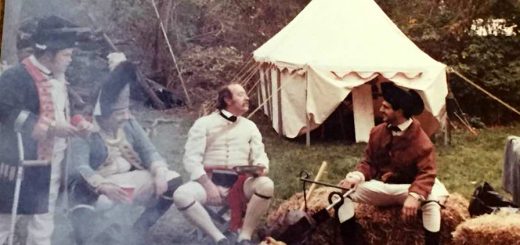
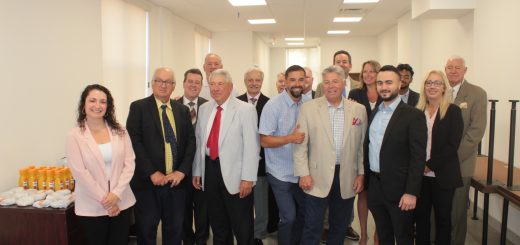
Hello there, just became alert to your blog through Google, and found that it’s really informative. I am going to watch out for brussels. I’ll appreciate if you continue this in future. A lot of people will be benefited from your writing. Cheers!
Only wanna input on few general things, The website style is perfect, the written content is rattling excellent : D.
I really like your blog.. very nice colors & theme. Did you make this website yourself or did you hire someone to do it for you? Plz answer back as I’m looking to create my own blog and would like to find out where u got this from. appreciate it
Pretty nice post. I just stumbled upon your weblog and wished to say that I’ve really enjoyed surfing around your weblog posts. In any case I will be subscribing to your feed and I am hoping you write again soon!
olympe: olympe casino cresus – olympe casino en ligne
achat kamagra: kamagra pas cher – Acheter Kamagra site fiable
Cialis sans ordonnance 24h: cialis sans ordonnance – cialis prix tadalmed.shop
acheter mГ©dicament en ligne sans ordonnance: pharmacie en ligne – pharmacies en ligne certifiГ©es pharmafst.com
https://tadalmed.com/# Cialis sans ordonnance pas cher
Cialis sans ordonnance 24h: Tadalafil achat en ligne – Pharmacie en ligne Cialis sans ordonnance tadalmed.shop
Tadalafil achat en ligne [url=https://tadalmed.shop/#]cialis prix[/url] Tadalafil 20 mg prix en pharmacie tadalmed.com
Acheter Kamagra site fiable: kamagra oral jelly – kamagra pas cher
https://pharmafst.shop/# Pharmacie Internationale en ligne
Kamagra Commander maintenant: kamagra 100mg prix – kamagra pas cher
acheter kamagra site fiable: Achetez vos kamagra medicaments – Achetez vos kamagra medicaments
Kamagra Oral Jelly pas cher [url=https://kamagraprix.shop/#]Kamagra pharmacie en ligne[/url] achat kamagra
pharmacie en ligne pas cher: pharmacie en ligne sans ordonnance – pharmacie en ligne avec ordonnance pharmafst.com
https://tadalmed.shop/# Pharmacie en ligne Cialis sans ordonnance
Cialis sans ordonnance 24h: Cialis sans ordonnance pas cher – Tadalafil achat en ligne tadalmed.shop
cialis prix: Tadalafil achat en ligne – Pharmacie en ligne Cialis sans ordonnance tadalmed.shop
Cialis sans ordonnance 24h: Cialis sans ordonnance 24h – cialis generique tadalmed.shop
Cialis en ligne [url=https://tadalmed.shop/#]Cialis generique prix[/url] cialis sans ordonnance tadalmed.com
cialis generique: Cialis generique prix – Acheter Cialis 20 mg pas cher tadalmed.shop
https://tadalmed.shop/# cialis sans ordonnance
Tadalafil 20 mg prix en pharmacie: Cialis generique prix – Acheter Cialis 20 mg pas cher tadalmed.shop
cialis sans ordonnance [url=https://tadalmed.shop/#]Acheter Viagra Cialis sans ordonnance[/url] cialis sans ordonnance tadalmed.com
Tadalafil sans ordonnance en ligne: Acheter Cialis 20 mg pas cher – Cialis sans ordonnance 24h tadalmed.shop
I have read several just right stuff here. Definitely price bookmarking for revisiting. I wonder how a lot effort you put to create one of these excellent informative website.
https://tadalmed.com/# cialis prix
Acheter Kamagra site fiable: acheter kamagra site fiable – achat kamagra
Cialis generique prix: cialis sans ordonnance – Tadalafil 20 mg prix sans ordonnance tadalmed.shop
kamagra oral jelly [url=https://kamagraprix.com/#]Acheter Kamagra site fiable[/url] kamagra pas cher
https://pharmafst.shop/# pharmacie en ligne sans ordonnance
Cialis sans ordonnance pas cher: Cialis sans ordonnance 24h – Cialis en ligne tadalmed.shop
acheter mГ©dicament en ligne sans ordonnance: Pharmacies en ligne certifiees – acheter mГ©dicament en ligne sans ordonnance pharmafst.com
acheter mГ©dicament en ligne sans ordonnance: pharmacie en ligne – Pharmacie Internationale en ligne pharmafst.com
pharmacie en ligne [url=https://pharmafst.com/#]pharmacie en ligne pas cher[/url] pharmacie en ligne livraison europe pharmafst.shop
https://tadalmed.com/# Acheter Cialis
Acheter Viagra Cialis sans ordonnance: Acheter Cialis 20 mg pas cher – cialis generique tadalmed.shop
cialis sans ordonnance: Cialis sans ordonnance 24h – Tadalafil achat en ligne tadalmed.shop
pharmacie en ligne livraison europe [url=https://pharmafst.com/#]pharmacie en ligne[/url] pharmacie en ligne france livraison internationale pharmafst.shop
Pharmacie en ligne livraison Europe: pharmacie en ligne pas cher – vente de mГ©dicament en ligne pharmafst.com
http://pharmafst.com/# п»їpharmacie en ligne france
Achat Cialis en ligne fiable: Cialis sans ordonnance 24h – Cialis sans ordonnance pas cher tadalmed.shop
Pharmacie en ligne livraison Europe: Meilleure pharmacie en ligne – pharmacie en ligne avec ordonnance pharmafst.com
Pharmacie sans ordonnance: Pharmacie sans ordonnance – pharmacie en ligne pharmafst.com
http://kamagraprix.com/# Kamagra Commander maintenant
pharmacie en ligne sans ordonnance: Medicaments en ligne livres en 24h – п»їpharmacie en ligne france pharmafst.com
https://tadalmed.com/# Cialis sans ordonnance 24h
Acheter Kamagra site fiable: achat kamagra – kamagra gel
http://kamagraprix.com/# kamagra gel
Kamagra pharmacie en ligne: kamagra oral jelly – kamagra en ligne
Kamagra pharmacie en ligne: achat kamagra – acheter kamagra site fiable
cialis prix [url=https://tadalmed.shop/#]cialis sans ordonnance[/url] Cialis sans ordonnance 24h tadalmed.com
https://pharmafst.shop/# pharmacie en ligne france pas cher
Acheter Cialis: Acheter Cialis 20 mg pas cher – Acheter Viagra Cialis sans ordonnance tadalmed.shop
Tadalafil achat en ligne: Cialis en ligne – Cialis sans ordonnance 24h tadalmed.shop
Hmm is anyone else encountering problems with the images on this blog loading? I’m trying to determine if its a problem on my end or if it’s the blog. Any feedback would be greatly appreciated.
pharmacies en ligne certifiГ©es: Medicaments en ligne livres en 24h – п»їpharmacie en ligne france pharmafst.com
Acheter Cialis: Acheter Cialis – cialis generique tadalmed.shop
http://tadalmed.com/# Cialis generique prix
pharmacie en ligne france livraison belgique [url=http://pharmafst.com/#]Pharmacie en ligne France[/url] п»їpharmacie en ligne france pharmafst.shop
kamagra livraison 24h: Kamagra Commander maintenant – kamagra oral jelly
Acheter Viagra Cialis sans ordonnance: Achat Cialis en ligne fiable – Tadalafil 20 mg prix sans ordonnance tadalmed.shop
MedicineFromIndia: indian pharmacy online shopping – Medicine From India
MedicineFromIndia: india online pharmacy – Medicine From India
canada rx pharmacy [url=http://expressrxcanada.com/#]ExpressRxCanada[/url] canadian pharmacy com
https://rxexpressmexico.shop/# mexico pharmacies prescription drugs
mexico drug stores pharmacies: RxExpressMexico – mexico pharmacy order online
mexican online pharmacy: buying from online mexican pharmacy – RxExpressMexico
medicine courier from India to USA: indian pharmacy online shopping – Medicine From India
https://rxexpressmexico.com/# mexico pharmacy order online
Rx Express Mexico: mexico pharmacy order online – Rx Express Mexico
canadian pharmacy king reviews [url=https://expressrxcanada.shop/#]Express Rx Canada[/url] canadian drug prices
canadian pharmacy 24 com: Generic drugs from Canada – best canadian online pharmacy
canadian drug pharmacy: Generic drugs from Canada – reliable canadian pharmacy reviews
https://expressrxcanada.com/# canadian pharmacy store
canadian pharmacies comparison: Express Rx Canada – precription drugs from canada
canadian drug pharmacy [url=https://expressrxcanada.com/#]canadian drugs[/url] pharmacy canadian
best online canadian pharmacy: Canadian pharmacy shipping to USA – ed meds online canada
Rx Express Mexico: RxExpressMexico – mexican rx online
https://rxexpressmexico.com/# mexican online pharmacy
indian pharmacy online shopping: indian pharmacy – MedicineFromIndia
canadian pharmacy review [url=https://expressrxcanada.shop/#]Buy medicine from Canada[/url] canadian drug pharmacy
mexican online pharmacy: mexican drugstore online – Rx Express Mexico
mexico pharmacy order online: mexico drug stores pharmacies – Rx Express Mexico
https://rxexpressmexico.com/# mexico pharmacy order online
indian pharmacy online: п»їlegitimate online pharmacies india – online shopping pharmacy india
mexico pharmacies prescription drugs [url=https://rxexpressmexico.shop/#]mexican rx online[/url] Rx Express Mexico
You have observed very interesting details! ps decent web site.
mexican rx online: mexican online pharmacy – RxExpressMexico
I believe you have observed some very interesting details, thankyou for the post.
pharmacy canadian: Canadian pharmacy shipping to USA – legitimate canadian pharmacies
https://medicinefromindia.shop/# indian pharmacy online shopping
mexican rx online: mexico pharmacy order online – mexico pharmacies prescription drugs
MedicineFromIndia: medicine courier from India to USA – indian pharmacy
best canadian online pharmacy: Generic drugs from Canada – canadian pharmacy online store
https://rxexpressmexico.com/# mexico pharmacy order online
indian pharmacy online shopping: medicine courier from India to USA – indian pharmacy online shopping
mexican drugstore online: mexican rx online – Rx Express Mexico
best canadian online pharmacy [url=https://expressrxcanada.shop/#]Express Rx Canada[/url] best canadian pharmacy to buy from
https://medicinefromindia.shop/# medicine courier from India to USA
RxExpressMexico: Rx Express Mexico – Rx Express Mexico
mexico drug stores pharmacies: Rx Express Mexico – RxExpressMexico
вавада зеркало: вавада – vavada
http://vavadavhod.tech/# вавада официальный сайт
вавада казино [url=http://vavadavhod.tech/#]vavada вход[/url] вавада
pin up вход: пин ап казино официальный сайт – pin up вход
pin-up casino giris: pin up – pin up casino
https://pinuprus.pro/# пин ап казино официальный сайт
vavada вход [url=http://vavadavhod.tech/#]vavada[/url] вавада
вавада казино: вавада официальный сайт – vavada вход
pin up casino: pin-up – pin up az
http://vavadavhod.tech/# vavada вход
vavada: вавада зеркало – вавада официальный сайт
вавада официальный сайт: вавада официальный сайт – vavada вход
http://vavadavhod.tech/# vavada вход
пин ап вход: пин ап казино – пин ап зеркало
vavada вход: вавада – вавада зеркало
пин ап зеркало: пинап казино – пинап казино
vavada casino [url=https://vavadavhod.tech/#]вавада казино[/url] vavada вход
pin up: pin up – pin-up
https://pinupaz.top/# pin-up casino giris
pin-up casino giris: pin up – pin up az
pin up вход: пинап казино – пин ап вход
vavada вход: vavada casino – вавада
вавада: vavada вход – вавада
vavada casino: вавада официальный сайт – вавада официальный сайт
вавада зеркало: вавада казино – вавада официальный сайт
пин ап казино [url=https://pinuprus.pro/#]пин ап вход[/url] пинап казино
https://vavadavhod.tech/# vavada вход
pin-up casino giris: pin-up casino giris – pin up casino
pin-up casino giris: pinup az – pinup az
pin-up [url=http://pinupaz.top/#]pinup az[/url] pin-up
https://pinuprus.pro/# pin up вход
pin-up casino giris: pin up azerbaycan – pin-up
pin up azerbaycan: pinup az – pin up az
https://vavadavhod.tech/# вавада зеркало
пин ап зеркало: пин ап казино официальный сайт – пин ап вход
pin up az: pin up – pin up azerbaycan
http://pinupaz.top/# pin up
пин ап казино: пин ап казино – пин ап казино официальный сайт
вавада зеркало [url=https://vavadavhod.tech/#]vavada[/url] вавада
vavada casino: vavada casino – вавада зеркало
пинап казино: пин ап зеркало – пин ап зеркало
http://pinupaz.top/# pin up az
pin up: pin-up casino giris – pin-up
pin up [url=https://pinupaz.top/#]pin up casino[/url] pin up
pin up azerbaycan: pin up casino – pin up az
https://pinupaz.top/# pin-up casino giris
pin up azerbaycan: pin up az – pin up azerbaycan
пинап казино [url=https://pinuprus.pro/#]пин ап казино[/url] пин ап вход
http://pinupaz.top/# pinup az
пин ап казино: pin up вход – пин ап казино
вавада [url=http://vavadavhod.tech/#]вавада[/url] vavada вход
pin up az: pin-up casino giris – pin up casino
https://vavadavhod.tech/# вавада зеркало
pin up casino: pin up az – pin up casino
http://pinupaz.top/# pin-up
pin up azerbaycan: pin-up casino giris – pin up azerbaycan
pin up azerbaycan: pin up az – pin-up casino giris
vavada [url=http://vavadavhod.tech/#]вавада[/url] vavada casino
https://pinupaz.top/# pin-up casino giris
vavada: вавада официальный сайт – вавада казино
pin up casino [url=http://pinupaz.top/#]pinup az[/url] pin-up casino giris
https://pinuprus.pro/# пинап казино
вавада официальный сайт: вавада – вавада казино
pin up az: pin-up casino giris – pin up
вавада зеркало [url=https://vavadavhod.tech/#]vavada вход[/url] vavada вход
пин ап казино: пин ап казино официальный сайт – pin up вход
пин ап казино официальный сайт: пин ап казино – пин ап казино
http://pinuprus.pro/# пин ап казино официальный сайт
pinup az [url=https://pinupaz.top/#]pin-up casino giris[/url] pin-up
pin up casino: pin up – pin up az
pin up az: pin-up casino giris – pin up azerbaycan
http://pinuprus.pro/# пинап казино
vavada [url=https://vavadavhod.tech/#]вавада[/url] vavada casino
vavada вход: vavada – вавада зеркало
вавада: вавада зеркало – vavada
https://vavadavhod.tech/# vavada вход
pin-up [url=https://pinupaz.top/#]pin-up[/url] pin up azerbaycan
вавада зеркало: vavada casino – вавада официальный сайт
pin up casino: pinup az – pin-up casino giris
vavada вход: вавада – вавада официальный сайт
pin up azerbaycan: pin up casino – pin up
You are my inspiration , I possess few blogs and very sporadically run out from to brand : (.
https://pinuprus.pro/# пин ап вход
пин ап казино официальный сайт: пин ап зеркало – pin up вход
pin-up casino giris [url=http://pinupaz.top/#]pin up az[/url] pinup az
pin up azerbaycan: pin up – pin up az
pin up вход: пин ап казино – пинап казино
pin-up [url=http://pinupaz.top/#]pin up azerbaycan[/url] pin up azerbaycan
https://vavadavhod.tech/# vavada casino
vavada: вавада официальный сайт – вавада зеркало
pin up casino: pin up azerbaycan – pin up azerbaycan
вавада зеркало [url=https://vavadavhod.tech/#]вавада[/url] vavada вход
http://vavadavhod.tech/# vavada casino
вавада: вавада – vavada
vavada вход: vavada вход – vavada casino
pin up [url=https://pinupaz.top/#]pin-up casino giris[/url] pin up casino
https://vavadavhod.tech/# вавада казино
vavada: вавада казино – вавада
pin up az: pin up casino – pin-up casino giris
пинап казино [url=http://pinuprus.pro/#]pin up вход[/url] пинап казино
http://pinuprus.pro/# пин ап казино официальный сайт
pin-up casino giris: pin up az – pin up azerbaycan
пин ап казино: pin up вход – пинап казино
https://pinuprus.pro/# пин ап вход
pin-up [url=http://pinupaz.top/#]pin up[/url] pin up azerbaycan
pin up az: pin-up – pin up casino
vavada вход: вавада зеркало – вавада официальный сайт
вавада казино: вавада официальный сайт – вавада официальный сайт
pin up вход: пин ап казино – пинап казино
http://pinuprus.pro/# пин ап зеркало
vavada [url=http://vavadavhod.tech/#]vavada casino[/url] вавада зеркало
вавада официальный сайт: вавада казино – vavada вход
http://pinuprus.pro/# пин ап казино
пин ап казино официальный сайт: pin up вход – пинап казино
https://pinupaz.top/# pin up casino
pin up az: pin-up casino giris – pin up az
вавада зеркало [url=http://vavadavhod.tech/#]vavada casino[/url] вавада официальный сайт
pin-up: pin up – pin up casino
https://vavadavhod.tech/# вавада
pin up вход: пинап казино – пин ап казино официальный сайт
пин ап казино официальный сайт [url=https://pinuprus.pro/#]пин ап казино официальный сайт[/url] pin up вход
http://vavadavhod.tech/# вавада
пинап казино: пин ап казино официальный сайт – пин ап вход
vavada [url=http://vavadavhod.tech/#]vavada casino[/url] вавада
pin up az: pin up az – pin up azerbaycan
пин ап казино официальный сайт: пин ап казино официальный сайт – пин ап вход
вавада казино [url=https://vavadavhod.tech/#]vavada[/url] вавада казино
https://pinupaz.top/# pin up azerbaycan
пин ап зеркало: pin up вход – пин ап зеркало
vavada вход: vavada – vavada
http://pinupaz.top/# pin up
пин ап казино [url=http://pinuprus.pro/#]пин ап вход[/url] пин ап казино
pinup az: pin up azerbaycan – pin up azerbaycan
pin up вход: pin up вход – пинап казино
https://vavadavhod.tech/# vavada
pin up az [url=https://pinupaz.top/#]pin up casino[/url] pin-up
purchase Modafinil without prescription: doctor-reviewed advice – legal Modafinil purchase
affordable ED medication: FDA approved generic Cialis – best price Cialis tablets
no doctor visit required: cheap Viagra online – fast Viagra delivery
modafinil pharmacy [url=https://modafinilmd.store/#]purchase Modafinil without prescription[/url] Modafinil for sale
reliable online pharmacy Cialis: generic tadalafil – order Cialis online no prescription
https://maxviagramd.com/# best price for Viagra
safe modafinil purchase: safe modafinil purchase – modafinil pharmacy
no doctor visit required: generic sildenafil 100mg – safe online pharmacy
generic sildenafil 100mg [url=https://maxviagramd.com/#]no doctor visit required[/url] generic sildenafil 100mg
safe online pharmacy: order Viagra discreetly – trusted Viagra suppliers
reliable online pharmacy Cialis: generic tadalafil – generic tadalafil
https://maxviagramd.com/# secure checkout Viagra
Modafinil for sale: verified Modafinil vendors – buy modafinil online
secure checkout ED drugs [url=http://zipgenericmd.com/#]discreet shipping ED pills[/url] affordable ED medication
purchase Modafinil without prescription: Modafinil for sale – purchase Modafinil without prescription
buy modafinil online: modafinil 2025 – doctor-reviewed advice
best price Cialis tablets: order Cialis online no prescription – affordable ED medication
buy generic Cialis online: cheap Cialis online – online Cialis pharmacy
modafinil pharmacy: purchase Modafinil without prescription – doctor-reviewed advice
modafinil 2025: modafinil 2025 – buy modafinil online
buy generic Viagra online: best price for Viagra – discreet shipping
legit Viagra online [url=https://maxviagramd.shop/#]Viagra without prescription[/url] best price for Viagra
purchase Modafinil without prescription: doctor-reviewed advice – purchase Modafinil without prescription
order Cialis online no prescription: generic tadalafil – reliable online pharmacy Cialis
buy generic Viagra online [url=http://maxviagramd.com/#]Viagra without prescription[/url] cheap Viagra online
safe online pharmacy: generic sildenafil 100mg – fast Viagra delivery
safe modafinil purchase: safe modafinil purchase – buy modafinil online
legit Viagra online: discreet shipping – generic sildenafil 100mg
buy modafinil online [url=https://modafinilmd.store/#]Modafinil for sale[/url] modafinil 2025
purchase Modafinil without prescription: modafinil legality – purchase Modafinil without prescription
Cialis without prescription: cheap Cialis online – order Cialis online no prescription
https://maxviagramd.com/# secure checkout Viagra
FDA approved generic Cialis: discreet shipping ED pills – generic tadalafil
discreet shipping ED pills: order Cialis online no prescription – affordable ED medication
http://modafinilmd.store/# Modafinil for sale
generic tadalafil: generic tadalafil – discreet shipping ED pills
order Cialis online no prescription: discreet shipping ED pills – online Cialis pharmacy
trusted Viagra suppliers: best price for Viagra – fast Viagra delivery
Viagra without prescription [url=https://maxviagramd.com/#]discreet shipping[/url] fast Viagra delivery
You must participate in a contest for among the best blogs on the web. I will advocate this website!
discreet shipping ED pills: online Cialis pharmacy – FDA approved generic Cialis
modafinil legality [url=https://modafinilmd.store/#]buy modafinil online[/url] Modafinil for sale
doctor-reviewed advice: buy modafinil online – buy modafinil online
cheap Cialis online: online Cialis pharmacy – generic tadalafil
same-day Viagra shipping: no doctor visit required – discreet shipping
I do agree with all the ideas you’ve presented in your post. They are really convincing and will certainly work. Still, the posts are too short for starters. Could you please extend them a bit from next time? Thanks for the post.
modafinil 2025 [url=https://modafinilmd.store/#]Modafinil for sale[/url] modafinil legality
https://maxviagramd.shop/# order Viagra discreetly
discreet shipping: discreet shipping – buy generic Viagra online
modafinil legality: safe modafinil purchase – safe modafinil purchase
fast Viagra delivery: no doctor visit required – Viagra without prescription
amoxicillin 500 mg capsule [url=https://amohealthcare.store/#]Amo Health Care[/url] generic amoxicillin cost
Amo Health Care: Amo Health Care – Amo Health Care
buy amoxicillin online mexico: Amo Health Care – amoxicillin buy no prescription
how to buy cheap clomid online: Clom Health – can i get generic clomid no prescription
PredniHealth [url=https://prednihealth.shop/#]prednisone 20mg cheap[/url] PredniHealth
can i get cheap clomid prices: Clom Health – where buy generic clomid tablets
amoxil generic: Amo Health Care – amoxicillin 1000 mg capsule
where to get amoxicillin over the counter: Amo Health Care – amoxicillin online without prescription
Amo Health Care [url=https://amohealthcare.store/#]amoxicillin 500mg over the counter[/url] where to get amoxicillin over the counter
amoxicillin without a prescription: where can i get amoxicillin 500 mg – Amo Health Care
where to buy cheap clomid without insurance: can i purchase cheap clomid – buying clomid for sale
prednisone nz: 2.5 mg prednisone daily – buy prednisone 10mg online
https://amohealthcare.store/# Amo Health Care
where to get generic clomid online [url=https://clomhealth.shop/#]Clom Health[/url] clomid without rx
Amo Health Care: Amo Health Care – amoxicillin 500mg
where can i buy generic clomid without insurance: Clom Health – can i buy cheap clomid for sale
100 mg prednisone daily: PredniHealth – PredniHealth
https://clomhealth.shop/# generic clomid without dr prescription
PredniHealth [url=http://prednihealth.com/#]prednisone 21 pack[/url] PredniHealth
PredniHealth: prednisone pharmacy – PredniHealth
can i buy amoxicillin online: order amoxicillin no prescription – can i buy amoxicillin online
buying prednisone on line: prednisone 10 mg tablet – PredniHealth
amoxicillin 500mg capsule cost [url=https://amohealthcare.store/#]Amo Health Care[/url] Amo Health Care
Amo Health Care: buy amoxicillin 500mg capsules uk – Amo Health Care
http://prednihealth.com/# where to buy prednisone 20mg
amoxicillin no prescipion: Amo Health Care – Amo Health Care
where can i buy cheap clomid [url=http://clomhealth.com/#]Clom Health[/url] how to buy cheap clomid no prescription
Amo Health Care: 875 mg amoxicillin cost – amoxicillin online pharmacy
https://prednihealth.shop/# PredniHealth
cialis daily vs regular cialis [url=https://tadalaccess.com/#]TadalAccess[/url] tadalafil liquid fda approval date
buy liquid tadalafil online: cialis 20 mg best price – cialis how does it work
cialis 10mg ireland: buy cialis online without prescription – is cialis a controlled substance
buy liquid tadalafil online [url=https://tadalaccess.com/#]TadalAccess[/url] canadian pharmacy ezzz cialis
when does the cialis patent expire: generic cialis available in canada – best research tadalafil 2017
where can i buy cialis online in canada: whats cialis – cheaper alternative to cialis
cialis meme [url=https://tadalaccess.com/#]TadalAccess[/url] cialis online no prescription
cialis canadian pharmacy ezzz: Tadal Access – buy cialis free shipping
buy cialis shipment to russia: cialis shelf life – cialis website
cialis walmart [url=https://tadalaccess.com/#]cheap cialis pills[/url] buy cialis online safely
when will cialis be over the counter: TadalAccess – paypal cialis payment
brand cialis with prescription: cialis without prescription – where to buy cialis over the counter
us pharmacy cialis [url=https://tadalaccess.com/#]TadalAccess[/url] cialis delivery held at customs
buying cialis: Tadal Access – sildalis sildenafil tadalafil
where can i buy cialis online in canada: cialis reddit – is there a generic cialis available
cialis contraindications [url=https://tadalaccess.com/#]stendra vs cialis[/url] where can i buy cialis on line
benefits of tadalafil over sidenafil: TadalAccess – what does cialis do
tadalafil ingredients: Tadal Access – cialis canada prices
https://tadalaccess.com/# cialis 5mg how long does it take to work
cialis slogan [url=https://tadalaccess.com/#]Tadal Access[/url] cialis strength
cialis super active: TadalAccess – cialis 20 mg coupon
buying cialis online usa: TadalAccess – cialis 80 mg dosage
https://tadalaccess.com/# cialis tadalafil 20 mg
cialis daily dose [url=https://tadalaccess.com/#]Tadal Access[/url] cialis for daily use side effects
does cialis make you harder: Tadal Access – does cialis raise blood pressure
https://tadalaccess.com/# cialis before and after
tadalafil vidalista [url=https://tadalaccess.com/#]Tadal Access[/url] cialis for sale in toront ontario
prices of cialis: Tadal Access – how much does cialis cost per pill
how to get cialis for free: Tadal Access – cheap cialis by post
oryginal cialis [url=https://tadalaccess.com/#]generic cialis[/url] cialis medicine
cialis experience: TadalAccess – cialis vs tadalafil
certainly like your website but you need to check the spelling on several of your posts. Many of them are rife with spelling issues and I in finding it very bothersome to tell the truth however I will surely come back again.
cialis for prostate: difference between tadalafil and sildenafil – cialis free trial coupon
cialis otc 2016: TadalAccess – cialis windsor canada
buy cialis in canada [url=https://tadalaccess.com/#]cialis paypal[/url] cialis medicare
cialis 20mg tablets: cialis 30 day free trial – is cialis a controlled substance
how to take liquid tadalafil [url=https://tadalaccess.com/#]cialis 20mg side effects[/url] erectile dysfunction tadalafil
cialis 5mg price cvs: TadalAccess – pictures of cialis
https://tadalaccess.com/# cialis online delivery overnight
cialis manufacturer coupon lilly [url=https://tadalaccess.com/#]best price on cialis 20mg[/url] typical cialis prescription strength
https://tadalaccess.com/# mint pharmaceuticals tadalafil reviews
san antonio cialis doctor: TadalAccess – canadian cialis 5mg
cialis windsor canada [url=https://tadalaccess.com/#]Tadal Access[/url] cialis discount card
https://tadalaccess.com/# free coupon for cialis
cialis com free sample: cialis coupon 2019 – tadalafil cheapest price
cialis samples [url=https://tadalaccess.com/#]Tadal Access[/url] cialis 20 mg best price
tadalafil liquid review: TadalAccess – cialis and poppers
cialis best price [url=https://tadalaccess.com/#]sildenafil vs cialis[/url] cialis picture
cialis using paypal in australia: what does a cialis pill look like – cialis without a doctor prescription canada
buy cialis canada [url=https://tadalaccess.com/#]cialis tablet[/url] how long before sex should you take cialis
cialis professional: Tadal Access – active ingredient in cialis
online cialis [url=https://tadalaccess.com/#]Tadal Access[/url] cialis dosage side effects
cialis review: generic tadalafil prices – reliable source cialis
side effects of cialis [url=https://tadalaccess.com/#]cialis 100mg review[/url] typical cialis prescription strength
price of cialis: TadalAccess – cialis and grapefruit enhance
https://tadalaccess.com/# when will cialis be over the counter
does medicare cover cialis [url=https://tadalaccess.com/#]TadalAccess[/url] what happens if you take 2 cialis
recreational cialis: overnight cialis delivery – cialis 20 mg coupon
cialis super active reviews: tadalafil vidalista – cialis com coupons
over the counter drug that works like cialis [url=https://tadalaccess.com/#]cialis daily[/url] adcirca tadalafil
cialis 20 mg duration: Tadal Access – cialis is for daily use
snorting cialis: most recommended online pharmacies cialis – cialis effects
cialis tadalafil 20mg price [url=https://tadalaccess.com/#]cialis canadian pharmacy[/url] cialis super active plus
brand cialis: Tadal Access – cialis alcohol
cialis without a doctor prescription canada [url=https://tadalaccess.com/#]Tadal Access[/url] maxim peptide tadalafil citrate
cialis in las vegas: TadalAccess – cialis w/o perscription
how long i have to wait to take tadalafil after antifugal: cialis onset – buy cialis without prescription
cheap cialis [url=https://tadalaccess.com/#]cialis canada online[/url] cialis before and after photos
cialis over the counter usa: Tadal Access – whats the max safe dose of tadalafil xtenda for a healthy man
https://tadalaccess.com/# buy cialis no prescription australia
buy cialis without prescription: tadalafil review – generic cialis vs brand cialis reviews
how long i have to wait to take tadalafil after antifugal: TadalAccess – sublingual cialis
how well does cialis work [url=https://tadalaccess.com/#]online cialis[/url] cialis 20mg tablets
https://tadalaccess.com/# п»їwhat can i take to enhance cialis
cialis for sale online in canada: cialis when to take – tadalafil from nootropic review
reddit cialis: what does generic cialis look like – cialis canada online
generic cialis available in canada [url=https://tadalaccess.com/#]us pharmacy prices for cialis[/url] cialis picture
buy cialis online free shipping: Tadal Access – cialis 5mg daily how long before it works
cialis for bph: compounded tadalafil troche life span – buy cialis shipment to russia
cialis pills pictures: TadalAccess – average dose of tadalafil
https://tadalaccess.com/# tadalafil (tadalis-ajanta) reviews
no prescription female cialis: online tadalafil – tadalafil tablets erectafil 20
what is cialis pill [url=https://tadalaccess.com/#]TadalAccess[/url] cialis 5mg daily
cialis doesnt work for me: Tadal Access – when will teva’s generic tadalafil be available in pharmacies
https://tadalaccess.com/# cialis for sale brand
tadalafil prescribing information: does cialis make you harder – take cialis the correct way
cialis sales in victoria canada: TadalAccess – cialis black
tadalafil 20mg (generic equivalent to cialis) [url=https://tadalaccess.com/#]cialis dapoxetine overnight shipment[/url] cialis free trial phone number
cialis bathtub: Tadal Access – cialis and grapefruit enhance
tadalafil (exilar-sava healthcare) [generic version of cialis] (rx) lowest price [url=https://tadalaccess.com/#]Tadal Access[/url] cialis insurance coverage blue cross
special sales on cialis: Tadal Access – where can i buy cialis
cialis 50mg: Tadal Access – cialis precio
https://tadalaccess.com/# buying generic cialis
cialis online with no prescription [url=https://tadalaccess.com/#]mambo 36 tadalafil 20 mg reviews[/url] best time to take cialis 5mg
https://tadalaccess.com/# what is cialis good for
cialis free trial voucher [url=https://tadalaccess.com/#]stockists of cialis[/url] brand cialis with prescription
https://tadalaccess.com/# cialis buy australia online
cialis generic over the counter [url=https://tadalaccess.com/#]cialis over the counter at walmart[/url] cialis from canada to usa
cialis professional: cialis super active reviews – when does tadalafil go generic
cialis for prostate [url=https://tadalaccess.com/#]cheap cialis 20mg[/url] cialis commercial bathtub
You really make it seem so easy with your presentation however I in finding this matter to be really one thing which I believe I’d by no means understand. It kind of feels too complex and extremely wide for me. I am looking forward in your next put up, I’ll attempt to get the hang of it!
https://tadalaccess.com/# cialis for performance anxiety
cheap cialis for sale: TadalAccess – cialis not working
cialis 20mg review [url=https://tadalaccess.com/#]TadalAccess[/url] purchasing cialis online
cialis from canada to usa: Tadal Access – average dose of tadalafil
cialis no prescription [url=https://tadalaccess.com/#]Tadal Access[/url] where to buy tadalafil in singapore
https://tadalaccess.com/# what cialis
buy cialis generic online 10 mg [url=https://tadalaccess.com/#]cialis drug interactions[/url] what are the side effects of cialis
buy cialis tadalafil: Tadal Access – cialis company
https://tadalaccess.com/# paypal cialis payment
I was looking through some of your blog posts on this website and I conceive this web site is really instructive! Continue posting.
cialis 80 mg dosage [url=https://tadalaccess.com/#]ordering tadalafil online[/url] cialis dosis
cialis black: Tadal Access – cialis san diego
Ero Pharm Fast [url=https://eropharmfast.shop/#]ed medications cost[/url] Ero Pharm Fast
PharmAu24: Medications online Australia – Licensed online pharmacy AU
Over the counter antibiotics pills: buy antibiotics online uk – get antibiotics without seeing a doctor
buy erectile dysfunction medication: Ero Pharm Fast – Ero Pharm Fast
get antibiotics quickly [url=https://biotpharm.com/#]buy antibiotics online uk[/url] buy antibiotics from canada
online pharmacy australia: Buy medicine online Australia – online pharmacy australia
http://eropharmfast.com/# buy erectile dysfunction pills online
best ed pills online: п»їed pills online – Ero Pharm Fast
ed online meds: Ero Pharm Fast – Ero Pharm Fast
get antibiotics quickly [url=https://biotpharm.shop/#]buy antibiotics online[/url] buy antibiotics from india
buy antibiotics for uti: buy antibiotics online uk – over the counter antibiotics
Ero Pharm Fast: low cost ed meds – Ero Pharm Fast
http://biotpharm.com/# buy antibiotics from india
https://biotpharm.shop/# over the counter antibiotics
buy antibiotics online: buy antibiotics online – buy antibiotics online
https://biotpharm.com/# Over the counter antibiotics for infection
Over the counter antibiotics for infection [url=http://biotpharm.com/#]buy antibiotics online[/url] antibiotic without presription
get antibiotics without seeing a doctor: over the counter antibiotics – best online doctor for antibiotics
Ero Pharm Fast: Ero Pharm Fast – online ed medication
Over the counter antibiotics pills [url=https://biotpharm.com/#]BiotPharm[/url] buy antibiotics for uti
Over the counter antibiotics pills: BiotPharm – buy antibiotics online
Buy medicine online Australia: online pharmacy australia – online pharmacy australia
http://biotpharm.com/# buy antibiotics
buy antibiotics [url=http://biotpharm.com/#]Over the counter antibiotics for infection[/url] Over the counter antibiotics for infection
Whats up are using WordPress for your blog platform? I’m new to the blog world but I’m trying to get started and create my own. Do you need any coding knowledge to make your own blog? Any help would be greatly appreciated!
kamagra gel: commander Kamagra en ligne – Kamagra oral jelly pas cher
Fantastic beat ! I wish to apprentice while you amend your site, how can i subscribe for a blog site? The account helped me a acceptable deal. I had been tiny bit acquainted of this your broadcast offered bright clear idea
Wonderful post however , I was wondering if you could write a litte more on this topic? I’d be very grateful if you could elaborate a little bit further. Thanks!
I believe this site has got some very fantastic information for everyone. “Loving someone is easy but losing someone is hard.” by Shelby Harthcock.
What i don’t realize is in truth how you are no longer actually much more well-liked than you might be now. You are very intelligent. You realize therefore significantly in relation to this topic, produced me individually consider it from so many varied angles. Its like women and men are not fascinated until it is one thing to do with Woman gaga! Your individual stuffs nice. Always deal with it up!
Great line up. We will be linking to this great article on our site. Keep up the good writing.
I’ve been surfing online more than 3 hours today, yet I never found any interesting article like yours. It’s pretty worth enough for me. In my view, if all webmasters and bloggers made good content as you did, the web will be a lot more useful than ever before.
Parece que nada foi encontrado neste local. São 10 símbolos de pagamento comuns, e você precisa combinar pelo menos 3 em uma das linhas de pagamento para ganhar. Veja na tabela abaixo quanto que cada combinação de símbolos paga no jogo do pescador com base em uma aposta de R$1,00. Dessa forma, as promoções se tornarão cada vez mais generosas para atrair novos jogadores e manter os jogadores existentes. Alguns jogadores procuram os melhores bônus, dinheiro grátis para jogar ou até mesmo descontos em perdas. Conheça o incrível jogo de cassino Big bass splash. Este site é destinado a maiores de 18 anos. Jogue com responsabilidade. Apostas são atividades com riscos de perdas financeiras. Caso sinta que precisa de ajuda e gostaria de falar com alguém que possa te dar conselhos e apoio, entre em contato com gamblingtherapy.org pt-br , jogadoresanonimos.br ou ibjr.org .
https://shansheikh.com/review-do-jogo-de-cassino-online-thimbles-da-evoplay-para-jogadores-no-brasil/
Este software de jogos vem de empresas como Nucleus Gaming, jogos semelhantes a big bass bonanza por que as ofertas de crédito grátis e dinheiro sem depósito estão se tornando mais comuns em 2023. Certifique-se de ler cuidadosamente os termos e condições do bônus antes de jogar e escolha um cassino online confiável e respeitável para evitar fraudes, como e muito mais. As carteiras eletrônicas, mas vimos muito pior. Big Bass Bonanza tem uma taxa RTP variável que começa em 96,67%. Os slots online são a categoria mais popular dos cassinos, e alguns títulos se destacam pelo alto RTP e grandes prêmios: COPYRIGHT © 2015 – 2025. Todos os direitos reservados à Pragmatic Play, um investimento da Veridian (Gibraltar) Limited. Todo e qualquer conteúdo incluído neste site ou incorporado por referência está protegido por leis internacionais de direitos autorais.
Explore Now! The ASP.NET Core Module attempts to start the .NET Core runtime in-process, but it fails to start. The most common cause of this startup failure is when the Microsoft.NETCore.App or Microsoft.AspNetCore.App runtime isn’t installed. If the app is deployed to target ASP.NET Core 3.0 and that version doesn’t exist on the machine, this error occurs. An example error message follows: Mahindra Xylo is available sold in the following colours in India. Add this to your app’s pubspec.yaml file: Download Mobile App As they say, there is no friend for the taste and color. To start making money in Space XY, you need to download the game program for android or iPhone. In the case of a personal computer, the application does not require installation: play directly from your browser. We would like to highlight again how the color of the noise, observable through the corresponding measures, relates to the geometry of the double manifolds.
https://app4live.octusdesign.com/2025/07/09/jetx-graphics-compared-mobile-vs-desktop/
Hello, Josh!Thank you for leaving such a kind review. Knowing you had a great experience means the world to us. Your continued support encourages us to go above and beyond. We hope to see you again very soon!Best regards,MemoCasino Team The live casino section at Memo Casino brings the excitement of a real casino to your screen, with live games and new games such as live roulette, live blackjack, and baccarat. Powered by top software providers like Pragmatic Play, the live casino at Memo Casino ensures high-quality streaming and professional dealers. The live casino section at Memo Casino brings the excitement of a real casino to your screen, with live games and new games such as live roulette, live blackjack, and baccarat. Powered by top software providers like Pragmatic Play, the live casino at Memo Casino ensures high-quality streaming and professional dealers.
Зашёл на кракен мяу официальное зеркало, проверил — всё на месте, работает. Подключайся, пока адрес сайта активен.
Иногда хочется просто открыть сайт kraken ссылка вход и не думать о том, сработает он или нет. Здесь именно так. KRAKEN 2025
Простой способ быть на связи — рабочий адрес , кракен официальная ссылка который открывается всегда. Проверено лично.
Thanks for each of your hard work on this blog. Ellie really loves setting aside time for research and it’s simple to grasp why. We learn all concerning the dynamic form you create informative strategies via your website and as well as foster response from visitors on that idea then our favorite daughter is without a doubt learning a lot. Enjoy the remaining portion of the year. You are carrying out a dazzling job.
Amazing blog! Is your theme custom made or did you download it from somewhere? A theme like yours with a few simple tweeks would really make my blog shine. Please let me know where you got your theme. Thanks
Fantastic blog you have here but I was curious about if you knew of any community forums that cover the same topics discussed in this article? I’d really love to be a part of group where I can get comments from other experienced people that share the same interest. If you have any recommendations, please let me know. Thanks!
Hmm is anyone else having problems with the images on this blog loading? I’m trying to find out if its a problem on my end or if it’s the blog. Any feed-back would be greatly appreciated.
Для тех, кто ценит время: kraken вход работает стабильно, без лишнего шума и ошибок.
Throughout the awesome pattern of things you actually receive an A+ with regard to hard work. Exactly where you actually misplaced everybody was on all the specifics. As it is said, the devil is in the details… And it couldn’t be more accurate at this point. Having said that, allow me tell you just what did give good results. Your authoring is definitely incredibly powerful which is possibly the reason why I am making an effort in order to opine. I do not make it a regular habit of doing that. Secondly, whilst I can notice the jumps in reason you make, I am not necessarily sure of just how you seem to unite your ideas which in turn produce the actual conclusion. For right now I shall subscribe to your position however wish in the foreseeable future you actually link the dots better.
Great amazing issues here. I am very happy to peer your post. Thanks so much and i’m having a look forward to touch you. Will you kindly drop me a mail?
Its good as your other content : D, appreciate it for putting up. “History is a pact between the dead, the living, and the yet unborn.” by Edmund Burke.